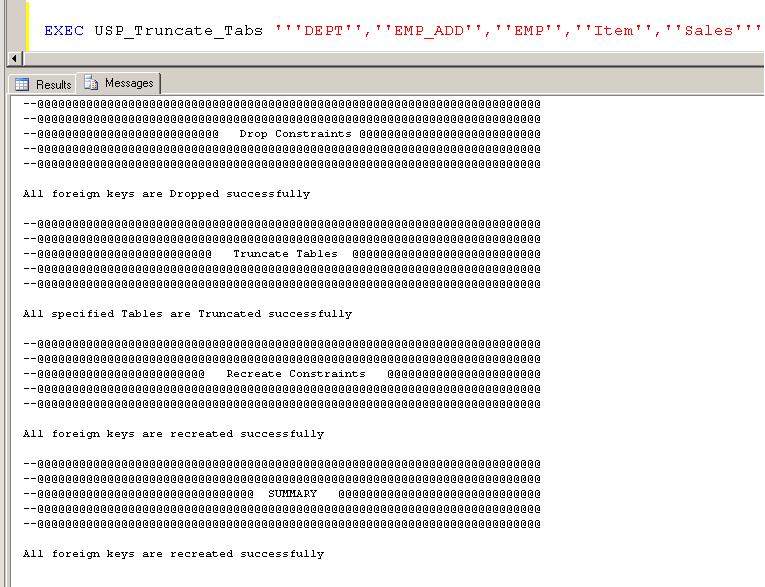Truncate Table with Foreign Key constraint
This post helps you in automating the process of Truncate Table with Foreign Key constraint”. We recently working for a client on data migration project. There was a requirement for truncating tables. But we had to face issues as all those tables are having foreign keys. So the requirement is :
- Everytime we’ll send you a list of tables to be truncated
- First collect all constraint details from those tables
- Drop all foreign keys
- Truncate tables
- Recreate all constraints
- If in-case of any failure the script should not fail or through any error message instead it should continue with the next object and failed objects / constraints should be printed
We built the below stored procedure to fulfill the client requirement and it worked perfectly as expected.
Stored Procedure Creation to Truncate Table with Foreign Key constraint:
IF EXISTS(SELECT 1 FROM SYS.SYSOBJECTS WHERE NAME='USP_Truncate_Tabs' AND TYPE='P')
BEGIN
DROP PROC USP_Truncate_Tabs;
END
GO
CREATE PROC USP_Truncate_Tabs(@String VARCHAR(7500))
AS
BEGIN
SET NOCOUNT ON
/*** Verify table existence if not avilable it creates anew table on master database ***/
IF NOT EXISTS(SELECT 1 FROM master.sys.sysobjects WHERE Name='Constraints' AND TYPE='U')
BEGIN
CREATE TABLE [master].[dbo].[Constraints]
(ID INT IDENTITY,
DropStmt VARCHAR(1000),
Createstmt VARCHAR(1000),
DropStatus BIT DEFAULT(1),
CreateStatus BIT DEFAULT(1),
TruncateStatus BIT DEFAULT(1),
LastUsed DATETIME DEFAULT(GETDATE()));
END
TRUNCATE TABLE [master].[dbo].[Constraints]
/*** Get the list of Tables from the input String ***/
DECLARE @Tab TABLE(ID INT IDENTITY,TabName VARCHAR(200))
DECLARE @SQL1 VARCHAR(8000)
SET @SQL1='SELECT NAME FROM sysobjects WHERE TYPE=''U'' AND name in('+(@String)+')'
INSERT INTO @Tab EXEC(@SQL1)
/*** Insert All Drop and Create dtatements into the table Constraints ***/
INSERT INTO [master].[dbo].[Constraints] (DropStmt,CreateStmt)
SELECT
'ALTER TABLE [' + ForeignKeys.ForeignTableSchema +
'].[' + ForeignKeys.ForeignTableName +
'] DROP CONSTRAINT [' + ForeignKeys.ForeignKeyName + ']; '
,'ALTER TABLE ['+ ForeignKeys.ForeignTableSchema +
'].[' + ForeignKeys.ForeignTableName +
'] WITH CHECK ADD CONSTRAINT [' + ForeignKeys.ForeignKeyName +
'] FOREIGN KEY([' + ForeignKeys.ForeignTableColumn +
']) REFERENCES [' + schema_name(sys.objects.schema_id) + '].[' +
sys.objects.[name] + ']([' +
sys.columns.[name] + ']); '
from sys.objects
inner join sys.columns
on (sys.columns.[object_id] = sys.objects.[object_id])
inner join (
select sys.foreign_keys.[name] as ForeignKeyName
,schema_name(sys.objects.schema_id) as ForeignTableSchema
,sys.objects.[name] as ForeignTableName
,sys.columns.[name] as ForeignTableColumn
,sys.foreign_keys.referenced_object_id as referenced_object_id
,sys.foreign_key_columns.referenced_column_id as referenced_column_id
from sys.foreign_keys
inner join sys.foreign_key_columns
on (sys.foreign_key_columns.constraint_object_id
= sys.foreign_keys.[object_id])
inner join sys.objects
on (sys.objects.[object_id]
= sys.foreign_keys.parent_object_id)
inner join sys.columns
on (sys.columns.[object_id]
= sys.objects.[object_id])
and (sys.columns.column_id
= sys.foreign_key_columns.parent_column_id)
) ForeignKeys
on (ForeignKeys.referenced_object_id = sys.objects.[object_id])
and (ForeignKeys.referenced_column_id = sys.columns.column_id)
where (sys.objects.[type] = 'U')
and (sys.objects.[name] not in ('sysdiagrams'))
/*** Drop all Constraints in the database and update the Constraints table for failed statements ***/
/*** From Constraints Table Status 1 - Success and Status 0 - Failed ***/
PRINT'@@@@@@@@@@@@@@@@@@@@@@@@@@@@@@@@@@@@@@@@@@@@@@@@@@@@@@@@'
PRINT'@@@@@@@@@@@@@@@@@@@@@@@@@@@@@@@@@@@@@@@@@@@@@@@@@@@@@@@@'
PRINT'@@@@@@@@@@@@@@@@ Drop Constraints @@@@@@@@@@@@@@@@@@@@'
PRINT'@@@@@@@@@@@@@@@@@@@@@@@@@@@@@@@@@@@@@@@@@@@@@@@@@@@@@@@@'
PRINT'@@@@@@@@@@@@@@@@@@@@@@@@@@@@@@@@@@@@@@@@@@@@@@@@@@@@@@@@'
DECLARE @Sql VARCHAR(1000)
DECLARE @i INT,@Max INT
SELECT @Max=COUNT(1)FROM [master].[dbo].[Constraints]
SET @i=1
WHILE(@i<=@Max)
BEGIN
SELECT @Sql=DropStmt FROM [master].[dbo].[Constraints] WHERE ID=@i
BEGIN TRY
EXEC(@Sql)
END TRY
BEGIN CATCH
UPDATE [master].[dbo].[Constraints] SET DropStatus=0 WHERE ID=@i
END CATCH
SET @Sql=''
SET @i=@i+1
END
/*** Check for the errors in droping the constraints ***/
IF NOT EXISTS(SELECT 1 FROM [master].[dbo].[Constraints] WHERE DropStatus=0)
BEGIN
PRINT'All foreign keys are Dropped successfully'
END
ELSE
BEGIN
PRINT'A result set retrived with the Failed Statements'
SELECT CreateStmt AS'FailedtoDrop'FROM [master].[dbo].[Constraints] WHERE DropStatus=0
END
/*** Truncate the tables specified in the input string ******/
/*** It directly echos the failed statements on results window ***/
PRINT' '
PRINT'@@@@@@@@@@@@@@@@@@@@@@@@@@@@@@@@@@@@@@@@@@@@@@@@@@@@@@@@'
PRINT'@@@@@@@@@@@@@@@@@@@@@@@@@@@@@@@@@@@@@@@@@@@@@@@@@@@@@@@@'
PRINT'@@@@@@@@@@@@@@@@ TRUNCATE Tables @@@@@@@@@@@@@@@@@@@@@@@'
PRINT'@@@@@@@@@@@@@@@@@@@@@@@@@@@@@@@@@@@@@@@@@@@@@@@@@@@@@@@@'
PRINT'@@@@@@@@@@@@@@@@@@@@@@@@@@@@@@@@@@@@@@@@@@@@@@@@@@@@@@@@'
PRINT' '
DECLARE @TabName VARCHAR(200)
SELECT @Max=COUNT(1)FROM @Tab
SET @i=1
WHILE(@i<=@Max)
BEGIN
SELECT @TabName=TabName FROM @Tab WHERE ID=@i
SELECT @Sql='TRUNCATE TABLE '+@TabName
BEGIN TRY
EXEC(@sql)
END TRY
BEGIN CATCH
UPDATE [master].[dbo].[Constraints] SET TruncateStatus=0 WHERE ID=@i
END CATCH
SET @Sql=''
SET @i=@i+1
END
/*** Check for the errors in Truncating the Tables ***/
IF NOT EXISTS(SELECT 1 FROM [master].[dbo].[Constraints] WHERE TruncateStatus=0)
BEGIN
PRINT'All specified Tables are Truncated successfully'
END
ELSE
BEGIN
PRINT'A result set retrived with the Failed Statements'
SELECT CreateStmt AS'FailedtoTruncate'FROM [master].[dbo].[Constraints] WHERE TruncateStatus=0
END
/*** Recreate all Constraints in the database and update the Constraints table for failed statements ***/
/*** From Constraints Table Status 1 - Success and Status 0 - Failed ***/
PRINT' '
PRINT'@@@@@@@@@@@@@@@@@@@@@@@@@@@@@@@@@@@@@@@@@@@@@@@@@@@@@@@@'
PRINT'@@@@@@@@@@@@@@@@@@@@@@@@@@@@@@@@@@@@@@@@@@@@@@@@@@@@@@@@'
PRINT '@@@@@@@@@@@@@@ Recreate Constraints @@@@@@@@@@@@@@@@'
PRINT'@@@@@@@@@@@@@@@@@@@@@@@@@@@@@@@@@@@@@@@@@@@@@@@@@@@@@@@@'
PRINT'@@@@@@@@@@@@@@@@@@@@@@@@@@@@@@@@@@@@@@@@@@@@@@@@@@@@@@@@'
PRINT' '
SELECT @Max=COUNT(1)FROM [master].[dbo].[Constraints]
SET @i=1
WHILE(@i<=@Max)
BEGIN
SELECT @Sql=CreateStmt FROM [master].[dbo].[Constraints] WHERE ID=@i
BEGIN TRY
EXEC(@Sql)
END TRY
BEGIN CATCH
UPDATE [master].[dbo].[Constraints] SET CreateStatus=0 WHERE ID=@i
END CATCH
SET @Sql=''
SET @i=@i+1
END
/*** Check for the errors in recreating the constraints ***/
IF NOT EXISTS(SELECT 1 FROM [master].[dbo].[Constraints] WHERE CreateStatus=0)
PRINT'All foreign keys are recreated successfully'
ELSE
PRINT'Foreign keys are recreated with errors look into Summary'
/***** Summary ******/
PRINT' '
PRINT'@@@@@@@@@@@@@@@@@@@@@@@@@@@@@@@@@@@@@@@@@@@@@@@@@@@@@@@@'
PRINT'@@@@@@@@@@@@@@@@@@@@@@@@@@@@@@@@@@@@@@@@@@@@@@@@@@@@@@@@'
PRINT'@@@@@@@@@@@@@@@@@@@@@@@ SUMMARY @@@@@@@@@@@@@@@@@@@@@@'
PRINT'@@@@@@@@@@@@@@@@@@@@@@@@@@@@@@@@@@@@@@@@@@@@@@@@@@@@@@@@'
PRINT'@@@@@@@@@@@@@@@@@@@@@@@@@@@@@@@@@@@@@@@@@@@@@@@@@@@@@@@@'
PRINT' '
IF NOT EXISTS(SELECT 1 FROM [master].[dbo].[Constraints] WHERE CreateStatus=0)
BEGIN
PRINT'All foreign keys are recreated successfully'
END
ELSE
BEGIN
PRINT'A result set retrived with the Failed Statements'
SELECT CreateStmt AS'FailedtoRecreate'FROM [master].[dbo].[Constraints] WHERE CreateStatus=0
END
/**** Second Attempt to Recreating the failed constraints if any ****/
IF EXISTS(SELECT 1 FROM [master].[dbo].[Constraints] WHERE CreateStatus=0)
BEGIN
PRINT' '
PRINT'@@@@@@@@@@@@@@@@@@@@@@@@@@@@@@@@@@@@@@@@@@@@@@@@@@@@@@@@'
PRINT'@@@@@@@@@@@@@@@@@@@@@@@@@@@@@@@@@@@@@@@@@@@@@@@@@@@@@@@@'
PRINT'@@@@@@ Final Atempt to Recreate Constraints @@@@@@@@@@'
PRINT'@@@@@@@@@@@@@@@@@@@@@@@@@@@@@@@@@@@@@@@@@@@@@@@@@@@@@@@@'
PRINT'@@@@@@@@@@@@@@@@@@@@@@@@@@@@@@@@@@@@@@@@@@@@@@@@@@@@@@@@'
PRINT' '
DECLARE @Recreate Table(ID INT IDENTITY,ConID INT,CreateStmt VARCHAR(1000))
INSERT INTO @Recreate (ConID,CreateStmt)SELECT ID,CreateStmt FROM [master].[dbo].[Constraints] WHERE CreateStatus=0
SELECT @Max=COUNT(1)FROM @Recreate
SET @i=1
SET @sql=''
WHILE(@i<=@Max)
BEGIN
SELECT @Sql=CreateStmt FROM @Recreate WHERE ID=@i
BEGIN TRY
EXEC(@Sql)
UPDATE [master].[dbo].[Constraints] SET CreateStatus=1 WHERE ID IN(
SELECT ConID FROM @Recreate WHERE ID=@i)
END TRY
BEGIN CATCH
PRINT'Final Attmept also Failed to Execute '+@sql
END CATCH
SET @Sql=''
SET @i=@i+1
END
PRINT' '
IF NOT EXISTS(SELECT 1 FROM [master].[dbo].[Constraints] WHERE CreateStatus=0)
PRINT'All foreign keys are recreated successfully in Final Attempt'
ELSE
PRINT'Final Attempt is also filed in recreating all foreign keys there might be problem with domain intigrity'
PRINT' '
END
END


















Although slick, your procedure does not handle multiple primary key constraints…